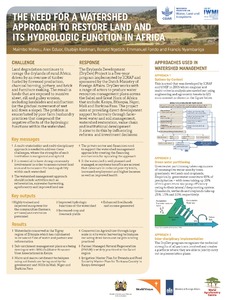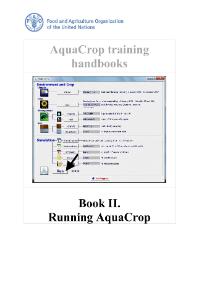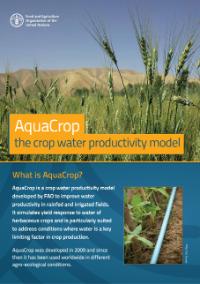The 'Trickle Down' of IWRM: a case study of local-level realities in the Inkomati Water Management Area, South Africa
The historical legacy in South Africa of apartheid and the resulting discriminatory policies and power imbalances are critical to understanding how water is managed and allocated, and how people participate in designated water governance structures. The progressive post-apartheid National Water Act (NWA) is the principal legal instrument related to water governance which has broadly embraced the principles of Integrated Water Resources Management (IWRM).
Water: the conveyor belt for sustainable livelihoods and economic development
Watershed moments: a photographic anthology celebrating 30 years of research for a water-secure world (1985–2015 and beyond)
Whose waters? large-scale agricultural development and water grabbing in the Wami-Ruvu River Basin, Tanzania
In Tanzania like in other parts of the global South, in the name of 'development' and 'poverty eradication' vast tracts of land have been earmarked by the government to be developed by investors for different commercial agricultural projects, giving rise to the contested land grab phenomenon. In parallel, Integrated Water Resources Management (IWRM) has been promoted in the country and globally as the governance framework that seeks to manage water resources in an efficient, equitable and sustainable manner.
Winners and losers of IWRM [Integrated Water Resources Management] in Tanzania
This paper focuses on the application of the concept of Integrated Water Resources Management (IWRM) in Tanzania. It asks: how did IWRM affect the rural and fast-growing majority of smallholder farmers' access to water which contributes directly to poverty alleviation and employment creation in a country where poverty and joblessness are high?
Yield and water use efficiency of furrow irrigated potato under regulated deficit irrigation, Atsibi-Wemberta, North Ethiopia
The pressure on availability of water in Tigray regional state is likely to increase as the requirement for food production in couple with rapidly growing of the population is at increasing rate. Hence, improving water productivity using regulated deficit irrigation is important to reduce the water consumption while minimizing adverse effects on the crop yield. This study was conducted in the eastern zone of Tigray regional state, Atsibi Womberta district.
Regional developments [In 2016 Global Food Policy Report]
In addition to global events and food policy changes, 2015 also saw important developments with potentially wide repercussions in individual countries and regions. This chapter offers perspectives on major food policy developments across the major regions: Africa, the Middle East and North Africa, Central Asia, South Asia, East Asia, and Latin America and the Caribbean.
AquaCrop training handbooks. Book II: Running AquaCrop. April 2017
This handbook is a training tool to learn how to run AquaCrop. AquaCrop is a crop water productivity model developed by the Land and Water Division of FAO to address food security and to assess the effect of environment and management on crop production. AquaCrop simulates yield response to water of herbaceous crops, and is particularly suited to address conditions where water is a key limiting factor in crop production.
AquaCrop, the crop water productivity model
AquaCrop is a crop water productivity model developed by FAO to improve water productivity in rainfed and irrigated fields. It simulates yield response to water of herbaceous crops and is particularly suited to address conditions where water is a key limiting factor in crop production. AquaCrop was developed in 2009 and since then it has been used worldwide in different agro-ecological conditions.
AquaCrop training handbooks. Book I: Understanding AquaCrop. April 2017
AquaCrop is a crop simulation model which describes the interactions between the plant and the soil. FAO developed AquaCrop to address food security and to assess the effect of environment and management on crop production . AquaCrop can be used as a planning tool or to assist in management decisions for both irrigated and rainfed agriculture. AquaCrop is particularly useful:






